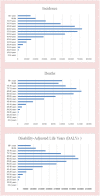The global incidence, mortality, and burden of uterine cancer in 2019 and correlation with SDI, tobacco, dietary risks, and metabolic risk factors: An ecological study
- PMID: 38274134
- PMCID: PMC10808991
- DOI: 10.1002/hsr2.1835
The global incidence, mortality, and burden of uterine cancer in 2019 and correlation with SDI, tobacco, dietary risks, and metabolic risk factors: An ecological study
Abstract
Background and aim: Endometrial cancer (EC) is the sixth most common cancer among women worldwide. Since global studies are based on awareness of the incidence trend, mortality, geographical diversity, and level of social development and income of countries, this study was conducted to investigate the trend of uterine cancer (UC) in the world in 2019.
Methods: Age-standardized rates (ASR) of incidence, deaths, prevalence, and disability-adjusted life years (DALYs) of UC, as well as targeted risk factors, were extracted from the Global Burden of Disease (GBD) online database 2019. Pearson correlation coefficient and SPSS 16 were used to calculate the correlation between risk factors and ASR of epidemiological indicators. Statistical significance was considered as p < 0.05.
Results: In 2019, the age-specific incidence and death rate of UC was peaking at 60-64 and 65-69 years, respectively. The highest age-standardized incidence rate per 100,000 people for UC has been reported in the Northern Mariana Islands, high sociodemographic index (SDI) countries, World Bank High-Income category, Europe continent and among World Health Organization (WHO) regions were found in the European Region. The highest age-standardized death rate per 100,000 people for UC has been reported in Grenada, high SDI countries, the World Bank High-Income category, Europe continent, and among WHO regions found in the European Region. In 2019, the age-standardized DALYs rate was 53.54 per 100,000 inhabitants, of which 48.49 cases were related to years of life lost (YLLs) and 5.05 cases were related to years lived with disability.
Conclusion: According to GBD-2019, the highest incidence, mortality, and DALY of UC are in Europe. The evidence and traces of diversity can be seen in the inequalities of UC. Race, ethnicity, economic status, level of education and awareness, co-morbidities, access, grade, and histological type of tumor are the most important causes of this inequality.
Keywords: burden; global; incidence; mortality; uterine cancer.
© 2024 The Authors. Health Science Reports published by Wiley Periodicals LLC.
Conflict of interest statement
The authors declare no conflict of interest.
Figures




References
-
- Sung H, Ferlay J, Siegel RL, et al. Global cancer statistics 2020: GLOBOCAN estimates of incidence and mortality worldwide for 36 cancers in 185 countries. CA Cancer J Clin. 2021;71:209‐249. - PubMed
-
- Berek JS, Matias‐Guiu X, Creutzberg C, et al. FIGO staging of endometrial cancer: 2023. Int J Gynaecol Obstet. 2023;162:383‐394. - PubMed
-
- Siegel RL, Miller KD, Jemal A. Cancer statistics, 2018. CA Cancer J Clin. 2018;68:7‐30. - PubMed
-
- Passarello K, Kurian S, Villanueva V. Endometrial cancer: an overview of pathophysiology, management, and care. Semin Oncol Nurs. 2019;35:157‐165. - PubMed
LinkOut - more resources
Full Text Sources

